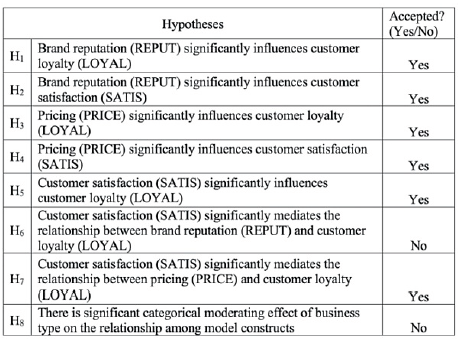1. Multi-group Analysis – “Business Type” in the Photocopier Manufacturer Example
Before starting this research project, Susan’s colleagues in the sales department keep telling her that non-profit business customers often behave very differently from for-profit ones in their decision-making processes. To confirm such insights, the last hypothesis is built as follows:
H8: There is significant categorical moderating effect of business type on the relationship among model constructs.
A multi-group analysis (PLS-MGA) is conducted using the parametric approach106 as suggested by Keil et al., (2000). This way, Susan can explore if there is any categorical moderating effect of business type (i.e., non-profit = group 1; for-profit = group 2) on her research findings. This kind of concern is understandable because heterogeneity may exist to show significantly differences in model relationships. Becker, Rai, Ringle, & Volckner (2013) advise that researchers who failed to consider this potential issue may draw incorrect conclusions.
The main idea is to check if the variances of the PLS parameter estimates (i.e. path coefficients) differ significantly across the 2 groups. The standard errors107 of the PLS parameter estimates can be found using the bootstrapping procedure—. As revealed in Figure 97, only 1 relationship (PRICE LOYAL) differs significantly— across the two groups. All other path coefficients do not differ significantly. The lack of heterogeneity leads us to reject the eighth hypothesis (H8) about the categorical moderation role of business type in the model.

Note: p(1) and p(2) are path coefficients of Group 1 and Group 2, respectively; se(p(1)) and se(p(2)) are the standard error of p(1) and p(2), respectively.
*p<0.10. **p<0.05. ***p<0.01 NS=not significant
2. Summary of Hypothesis Testing
All of the hypotheses except two are accepted in Susan’s research, and their results are summarized in Figure 98. REPUT is found to have significant impact to both LOYAL and SATIS (H1 & H2), whereas PRICE significantly influences these two endogenous variables as well (H3 & H4). It has also been found that SATIS maintains a significant linkage to LOYAL (H5). Meanwhile, SATIS serves as a significant mediator to the relationship between PRICE and LOYAL (H7). There is no significant categorical moderating effect of the business type in the model so the last hypothesis (H8) is rejected.

Figure 98: Summary of Hypothesis Testing
3. Managerial Implications for the Photocopier Manufacturer
This research has provided Susan with several insights into her photocopier business, especially the factors that drive loyalty from her business customers. The following findings and managerial implications can be drawn: [1] [2] [3] [4]
[1] Customer loyalty is influenced by several factors, including but not limit to brand reputation, product pricing, and customer satisfaction. Resources have to be allocated to look after these areas in general.
[2] Out of these three factors, brand reputation is the most important one, followed by pricing and then customer satisfaction. That means the company should make brand reputation management a priority, in case sufficient resources are not available to manage these three areas at the same time.
[3] Brand reputation is not a single-dimension factor. Instead, it is mostly affected by customers’ perception of the company’s product/service quality and financial performance, followed by its governance and leadership performance. Resources should be allocated in this sequence if they are limited. Contrary to common belief, this research does not find corporate social responsibility to have any significant relationship with brand reputation. As such, the company should first focus on the mentioned four areas of brand reputation before increasing the company’s corporate social responsibility initiatives.
[4] This research shows that customer satisfaction significantly mediates the strengths between pricing and loyalty. This means that if the customers are dissatisfied, they may not become loyal to the photocopier manufacturer even if the price is reasonable. As a result, account managers should not simply focus on getting the lowest pricing for their customers; it would be more important for them to understand their customers’ needs, react to their concerns, and keep them satisfied.
Source: Ken Kwong-Kay Wong (2019), Mastering Partial Least Squares Structural Equation Modeling (Pls-Sem) with Smartpls in 38 Hours, iUniverse.

28 Sep 2021
23 Oct 2019
28 Sep 2021
28 Sep 2021
28 Sep 2021
28 Sep 2021